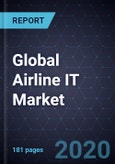Innovative Implementation of Digital Technologies to Unlock Airline Revenues and Generate Savings of up to $25 Billion by Improving Operational Efficiencies
Airlines are facing an ever-evolving digital landscape and an increase in expectations from an always-connected passenger. Cloud computing, mobile solutions, machine learning (ML), Blockchain, etc. are disrupting numerous traditional processes across industries. Airlines have lagged behind other industries in embracing these digital enablers, but many have begun their digital transformation (DT) journey that will fundamentally change the traditional airline information technology (IT) strategies.
The major challenge for airlines is their dependence on legacy systems for their critical IT needs. Solution providers are developing digital solutions that will enable airlines to overcome this challenge and help them grow in their DT endeavors. The airline industry has faced numerous cyber threats over the past couple of years and such incidents have brought the focus of leaders to cybersecurity. In such a scenario, airlines are trying to navigate their way in the new digital age, where protection of personal data is of high priority to passengers and governments are getting stricter on data regulation policies. Optimization of operations and hyper-personalization are key areas of focus for airlines globally. Growth in public awareness about climate change has put the aviation industry in the crossfires of a global backlash regarding the emissions levels that harm the environment. The industry is tackling this challenge by investing in alternate sustainable fuels, electric propulsions, etc. However, these measures will only be realized and implemented over the very long term. Currently, airlines are implementing solutions that are integrated with ML algorithms that can optimize operations, delivering reduced costs and emissions.
Customers are becoming more mobile and are always online and connected. Their experience in other aspects of life such as retail shopping, business, and even relationships are served in an intelligent manner curated to their preferences. Airlines are trying to reach the level of personalization provided by such industries to gain more of the opportunity in ancillary products by pitching the right product to potential passengers at the right time. Numerous start-ups in various stages of growth are developing niche technologies that can improve the particular processes of an airline. Airlines and solution providers are partnering and investing in these start-ups to support their digital growth.
The airline IT market is segmented into 6 key categories across various airline business models - Full-Service Carriers, Hybrid Carriers, Low-Cost Carriers, and Logistic Carriers. The 6 segments are IT Infrastructure, Operational IT, Commercial IT, Passenger Service Systems, Core Airline IT, and Corporate IT. There is also growing support and investment from international industry associations like the International Air Transport Association (IATA) to simplify and improve processes using digital solutions.
Research Scope
- Product Scope: Airline IT Systems, Segmentation of Airline IT, Key Market and Technology Trends
- Geographic Scope: Global
- End-user Scope: IT solution providers and firms that specialize in DT specific to the airline industry
Key Issues Addressed
- What is the current market for airline information technology, and how will it change by 2025?
- What are the various segments making up the airline IT market? How much does each segment contribute to the overall airline IT market and how will the composition change by 2025?
- What are the major digital trends on which airlines are focusing on? How do airlines plan to solve their pain points by using digital technologies?
- Who are the key solution providers in the market, and how are they responding to the new trends in the airline industry?
- Who are the disruptors in this area, and how will they impact the current market for the incumbent solutions providers?
Table of Contents
Companies Mentioned (Partial List)
A selection of companies mentioned in this report includes, but is not limited to:
- Amadeus
- Datalex
- IBS Software Services
- Jeppesen
- Lufthansa Systems
- Navblue
- PROS
- Sabre
- SITA
- Swiss Aviation Software Ltd.
- Travelport
- Travelsky
- Unisys








